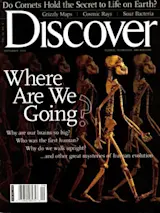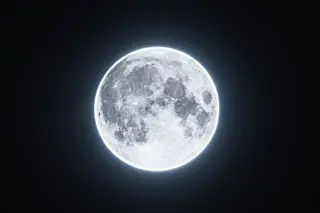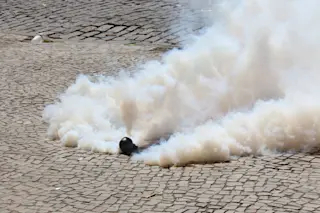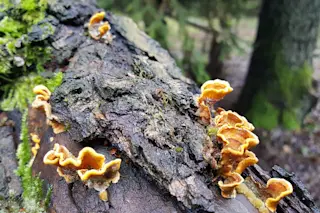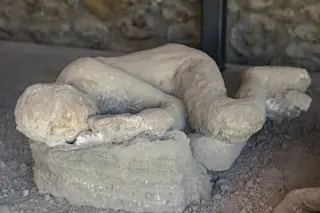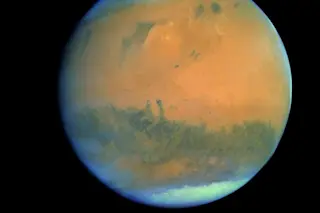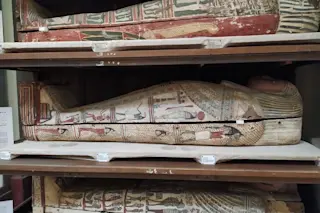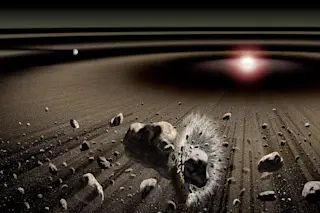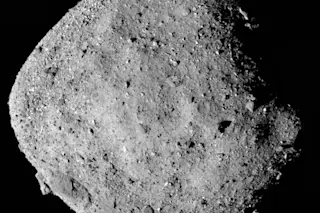Astronomer Don Brownlee's third floor office is cluttered with space paraphernalia, much of it tinged with a whiff of nostalgia for past triumphs: a piece of insulating tile from the first space shuttle flight; a plaque from the first U.S. satellite; models of pioneering solar-system probes. On the walls there is a gorgeous painting of Halley's comet floating over Antarctica in 1986, along with a whimsical illustration of an Apollo-era astronaut on the moon, gazing at Earth and urinating in a graceful arc onto lunar soil.
But one item—a nearly invisible block of stuff on a shelf next to an orange Slinky—points squarely to the future. This strange translucent cube has a faint blue sheen, like a frozen puff of cigarette smoke, and an inch-wide piece of it feels as light as air. It crumbles when I squeeze it, coating my fingertips with something that feels like sticky talcum powder. Brownlee says this chunk of almost-nothing is called aerogel and that a piece of it the size of a person would weigh less than a pound. It feels weirdly adhesive because it consists of countless loosely clumped clusters of silica dioxide molecules, essentially tiny bits of glass. "You'll inhale some particles, and your mouth will taste funny," Brownlee warns, just as a dry metallic taste hits me.
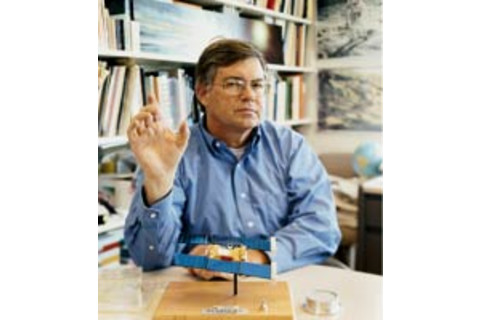
Don Brownlee (above, holding a piece of aerogel) speculates in the book Rare Earth, which he wrote with geologist Peter Ward in 2000, that our home planet is a remarkably special place because complex life formed here and probably nowhere else. However, he also guesses that microbial life may be relatively commonplace in the universe. As principal investigator for NASA's Stardust team, he is content to capture tiny lifeless particles from comet Wild 2 in aerogel (below). The spongy substance shows streaks where tiny glass spheres were fired into it to simulate comet particles. The streaks are cone shaped and wider where the particles first hit | Photographs by Tom Tavee
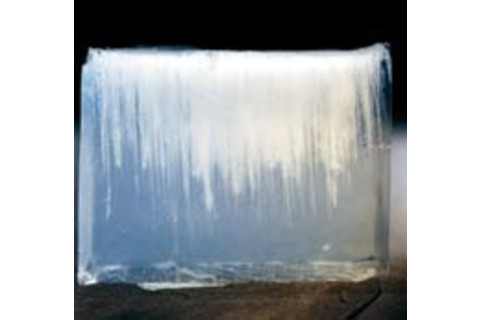
Much larger cubes of aerogel are 205 million miles from Earth, flying aboard a remarkable NASA spacecraft called Stardust. The probe, which Brownlee oversees from the University of Washington in Seattle, is hurtling toward a meeting with comet Wild 2 (pronounced in the German fashion as "vilt" 2). Aerogel and Wild 2 should meet each other this January. When Stardust flashes past, dust shed from the comet will strike the aerogel at a speed some six times that of a rifle bullet. The aerogel will snare the particles, and two years later Stardust will return to Earth. The precious payload—comet flecks embedded in aerogel and protected by a heat-resistant casing—will parachute to the desert floor in Utah.
Stardust is one of as many as four missions that promise to finally unveil the mysteries of what comets are made of and how they work. Each probe will bring unusual, often untested technologies to the task. One spacecraft, called Deep Impact, will attempt to blast a huge hole in a comet; another is intended to land on a comet and scoop up parts of its surface. Why spend all this time, money, and thought to study objects that astronomers often describe as little more than "dirty snowballs"? Because of what lies frozen inside. Comets are the most primitive objects in the solar system, preserved samples of the raw ingredients that formed Earth and the other planets. "We wouldn't be here without them," says Don Yeomans of NASA's Jet Propulsion Laboratory, in Pasadena, California. "We may well owe our existence to these things."
Comets crashing into Earth more than 4 billion years ago may have delivered much of the water that makes life here possible, Yeomans says. Those impacts may also have seeded Earth with carbon-rich components, possibly creating the chemical conditions that led to the origin of life. Comets even allow us to retrace our history to the time before the sun and the planets were born. "We think comets are made of interstellar grains, perhaps formed around millions of stars in the Milky Way," Brownlee says as he handles a piece of aerogel. "If that's true, our mission will return a nanobucket of star dust to Earth. . . . This is a treasure hidden in our own backyard. It's like going out and getting a piece of the galaxy."
Stardust and Deep Impact will be the first two probes to test these sweeping ideas. As Stardust heads back to Earth with its flecks of Wild 2, Deep Impact will be getting ready to launch an 820-pound copper bullet into comet Tempel 1. The results of those fireworks—scheduled, appropriately enough, for the Fourth of July in 2005—should expose the interior of a comet for the first time. Toward the end of the decade, another NASA mission may swing past as many as three comets. The more encounters the better, because no two comets are alike. "Comets all have different personalities," says Robert Farquhar of the Johns Hopkins University Applied Physics Laboratory. But in order to see those differences, he says, "you've really got to get up close." Finally, in 2014, Rosetta, a European mission, will attempt a landing on the comet Churyumov-Gerasimenko.
Our history of trying to get close to comets has been dismal: It has happened only four times, and fleetingly. A flurry of spacecraft, led by a European craft called Giotto, flew past Giacobini-Zinner in 1985 and Halley's comet in 1986. Then, except for a minor encounter by Giotto with comet Grigg-Skjellerup, 15 years passed. "For a long time, comet missions did not have pizzazz," says Benton Clark, chief scientist for space exploration systems at Lockheed Martin, near Denver. "NASA was still in the business of conquering planets and taking grand tours. Comets were strange little objects, and there were only a handful of comet experts in the world."
Then in 1996 and 1997 two bright comets passed spectacularly close to Earth, and comets became instant celebrities. "Hale-Bopp and Hyakutake really raised the interest level," Clark says. Comet probes also fit neatly into NASA's new budget commands of faster, better, and cheaper. Comet researchers got a bonus in 2001 when NASA's Deep Space 1 probe zipped by comet Borrelly. Although the mission was flown to test new types of propulsion and navigation systems, the technology worked well enough to get Deep Space 1 to Borrelly.
Photos of Borrelly and Halley exposed a startling truth about comets: They're darker than charcoal. On the outside at least, the so-called dirty snowballs look like all dirt and no snow. Our handful of decent images show rugged black lumps spouting jets of gas and dust that erupt from their interiors. Close to the sun, the material stretches into a long, tenuous tail that reflects sunlight. Only then does a comet shimmer serenely in the sky. "What we see in a picture of a comet is not a comet at all," says Brownlee. "It's the comet coming apart. The real comet is the black rock in the middle."
Astronomers suspect the black coatings are full of carbon-rich compounds. It's anyone's guess, however, whether the stuff is powdery or rock solid. Without enough data to draw on, scientists have to rely on their imaginations when describing the surfaces of comets. Astrophysicist Carey Lisse of the University of Maryland compares them to "smoking parking lots" tortured by exposure to sunlight. "Their surfaces get baked and roasted by the sun until they are darker than asphalt. Every once in a while they crack, and flakes and chunks come off."
Brownlee has been trying to extract grand stories from tiny space particles since the mid-1960s. A highlight of his graduate student days at the University of Washington was working on collectors that flew on Gemini 10 and Gemini 12. Designed to detect micrometeorites, the metal-coated glass plates registered no impacts during six hours outside the capsules. "We saw lots of astronaut urine," says Brownlee, glancing at his mischievous moon painting. "It crystallized into flakes when they dumped it and formed soap-ring structures on the plates. People thought the flux of particles from space would be a million times greater than it is and that the first satellites would erode away within a year. Obviously, they didn't."
Still, there is plenty of stuff to run into up there—about 40,000 tons of extraterrestrial dust wafts down onto Earth every year. Brownlee has analyzed hundreds of such particles. He estimates that about one-quarter of them were shed by comets. The rest came from asteroids, which collide and spray dust through the inner solar system. The asteroid fragments are interesting in their own right, but only the comet bits contain intact, unaltered samples of the cold, dark nebula that eventually evolved into our solar system.
The particles that make up comets began life as the dying breaths of previous generations of stars. When a star runs out of hydrogen fuel in its core, it expands into a bloated red giant. Its atmosphere cools off drastically, allowing minuscule grains of carbon, silicon, and oxides to form. The grains are the size and color of black smoke particles, about four-millionths of an inch wide. Born in red giant stars or supernovas, they drift through the galaxy and eventually mingle with interstellar clouds of gas and dust, the places where new stars and planets arise.
On the outskirts of our young solar system, such dust grains stuck together with tiny grains of ice—now known to be common throughout space. These granules gradually accumulated into blobs of icy, dusty fluff as large as big cities. Trillions of these infant comets formed in the region where Jupiter, Saturn, Uranus, and Neptune now orbit. When the comets drifted near one of the giant planets, gravitational slingshot interactions propelled many of them to the Oort cloud, a zone of comets far beyond Pluto's orbit. Most are still there, orbiting extremely slowly until a disturbance—from a passing star, for instance—nudges them back toward the sun.
These comets dive inward on cigar-shaped orbits that take millions of years to complete. But as they pass closer and closer to Jupiter, the planet can fling them out of the solar system entirely or jostle their orbits into smaller loops. Comet Wild 2, the quarry of Stardust, became a Jupiter-family comet in 1974 when the gas giant's gravity shrank its orbit and corralled it inward, toward Mars and Earth. Because Wild 2 has ventured close to the sun only five times since then, Brownlee thinks it is a fairly fresh comet, with less of the black crust that insulates older bodies that have been cooked repeatedly by the sun.
Stardust will study Wild 2 with a camera and other instruments, but its main goal is to snatch thousands of the motes streaming off the comet's nucleus. "The other missions are studying the paintings," Brownlee says. "We're studying the paint. It's like taking the Mona Lisa and obliterating it with sandpaper."
Getting a peek inside a comet is every bit as challenging as deciphering Mona Lisa's enigmatic smile. Peter Tsou, a planetary scientist at JPL, has labored since 1982 to collect dust from a comet; Stardust was his 13th proposal. In the beginning, the idea of landing on a comet, digging up a sample, and then flying it back was outrageously expensive, potentially costing billions of dollars. Tsou realized that "a comet is a self-excavating body. You don't have to land on one to get a sample and bring it back to Earth." Unfortunately, no one knew exactly how to trap the particles whizzing by. Comet dust particles would hit a canister or containment device with such force that they would burn up or smash themselves into molecule-size bits.
"How do I catch something moving many times faster than a speeding bullet without melting or vaporizing it?" Tsou asked colleagues. "I talked to a lot of scientists. They just laughed at me." Eventually, he figured out that he would need a shock-absorbing material to slow the particles down gradually—perhaps a load of fibers that could absorb the particle whole, just as a bale of hay can stop a bullet without flattening it.
First he tested Styrofoam, using a high-powered gun at NASA's Ames Research Center in Moffett Field, California, to slam tiny aluminum balls into it. "The first time it worked, I ran up to my boss and said, 'I caught one!'" Tsou remembers. But he decided Styrofoam would not work for comet missions, because it would disintegrate under the sun's UV radiation in about a week. And because Styrofoam is opaque, comet dust would be impossible to find. To find bits of embedded dust far smaller than the thickness of a hair, scientists would need a collecting material that was transparent.
Then in the late 1980s, while on a visit to Los Alamos National Laboratory in New Mexico, Tsou saw a piece of aerogel sitting on a researcher's windowsill. Aerogel was first created by chemist Samuel Kistler in the 1930s and offered by the Monsanto Company for paints, cosmetics, and toothpaste. Decades later, physicists at Los Alamos discovered that it worked well as insulation for fusion research and for a classified weapons program. When Tsou tried it on small high-speed particles, it did the trick. The particles formed obvious tracks as they plowed to a stop in the clear gel. The tracks were 100 to 1,000 times as long as the widths of the particles, and they looked like arrows pointing to the flecks at the end.
Tsou worked with scientists at Lawrence Livermore National Laboratory in California to make the aerogel even lighter to improve its particle-catching ability. After years of testing—aerogel flew to the space station Mir and in the open cargo bay of the space shuttle—Tsou was ready to propose the Stardust mission. The aerogel on Stardust is as light as two ounces per cubic foot—so light that a block the size of a king-size mattress weighs five pounds. "It's truly a miracle material," says Brownlee. "It's beautiful. Sometimes it's so clear that it's hard to find it on your desk."
When Stardust approaches Wild 2 in a few months, the spacecraft will raise a tray of ice-cube-size chunks of aerogel on an arm shaped like a tennis racket. Grains of comet dust will slice into the gel and briefly heat up tiny streaks to hundreds of degrees as they screech to a stop. Earlier, in 2000 and 2002, the craft positioned aerogel collectors on the opposite side of the arm to snare particles of interstellar dust, suspected to be as small as one-tenth the size of comet grains. That dust should be younger than comet dust, and Brownlee hopes to compare the two types.
When the particles come back to Earth, researchers will probe them with laser light and extract some with tungsten fibers or microtweezers that will ease particles out of the aerogel along their impact tracks. Labs around the world will then set about analyzing the samples. If they look anything like the comet dust that Brownlee thinks he sees drifting into Earth's atmosphere, the particles should resemble exploded kernels of popcorn.
Anytime scientists talk about bringing samples from space back to Earth, they worry about the danger of contamination. Michael Zolensky, curator of the Houston facility where NASA will store Stardust's aerogel, says the dust poses no danger of unleashing a real-life Andromeda Strain. "Comet grains enter our atmosphere day and night, less altered than the ones we'll get from the aerogel," Zolensky says. Any viruses, spores, or other biological material should be sterilized by the heat of their entry into the aerogel.
The bigger unknown is whether Stardust's comet samples will make it back to Earth at all. When the spacecraft swings by our planet in January 2006, nearly seven years after launch, it will have to release the protective capsule containing the aerogel on precisely the right trajectory. If it comes in too shallowly, it will skip off the atmosphere; if it arrives too steeply, it will burn up. An error greater than eight-hundredths of an angular degree would most likely spell doom. That's the equivalent of aiming a golf ball accurately enough to make a 250-foot-long putt. "We will have had seven years of experience and practice in pointing the spacecraft," says Tom Duxbury, the Stardust mission manager at JPL. "We can meet this level of accuracy."
Still, Brownlee's mouth will be as dry as the dust of the Utah desert on January 15, 2006. "It's either going to be a great success or a total failure," he says, putting his forehead on his desk. "We'll know when we open the box."
At the University of Maryland in College Park, a huge football stadium looms over the brick building that houses the astronomy department. That seems appropriate, because some of the scientists there intend to gouge a stadium-size crater out of comet Tempel 1. They're taking the brute-force approach to understanding comets.
The mission, called Deep Impact (the name was chosen before the movie came out), could not be more different from the delicate catch-and-return strategy of Stardust."Deep Impact is a boy mission. None of this namby-pamby go in, rendezvous, and have a relationship with the comet. It's going to be really cool, really fast. We get to put a nice big hole in this thing, go kablooey, and see what the heck is inside it. So it has a little aspect of being 10 years old, throwing a rock at something, and breaking it up," says Carey Lisse, one of the mission's lead scientists.
This gung-ho attitude makes some researchers cringe. "I realize the public identifies with it as a Buck Rogers-type thing," says one scientist who asked that his name be withheld. "But I'm not sure it will tell us more than other missions are already telling us, and I'm not sure it will work." But the Deep Impact team is convinced an aggressive approach is justified, because scientists simply do not know what lies beneath the surface of a comet. The inner material might be as hard as concrete or as soft as a new snowbank. The black, sunbaked crust covering the comet could be a quarter-inch thick, or even a dozen feet. Smaller "cometesimals" might loosely join to make a nucleus riddled with weak seams, or the whole thing could be a coherent icy dirt ball. "It's like we're trying to see under a car cover, and we don't know whether it's a beat-up old car or a brand-new Jaguar," says JPL planetary scientist Jacklyn Green.
Deep Impact will race toward comet Tempel 1 after its launch on December 30, 2004. One day before its comet encounter on the following July 4, the parent ship will release a "smart impactor"—an 820-pound mass of copper and aluminum, equipped with a camera and small thrusters to help steer toward the target. The flyby vessel will slow down and record the crash through telescopes as the nucleus and the impactor slam together at 6.2 miles per second, generating an explosive force of 4.5 tons of TNT. "At that instant, we won't know what's going to happen," says Green. "It's like a real-life experiment with a spacecraft."
Project director Michael A'Hearn, a jovial and bearded man who favors shorts and Hawaiian-print shirts on Maryland's sweltering summer days, has an educated guess. "My gut feeling is that we will excavate a crater, get down to where there is a lot more volatile ice than near the surface, and create a new active area that will persist for months," he says. "It also would not amaze me if we split the comet and broke off a small piece."
The most likely model predicts that the impactor will create a crater 400 feet in diameter and nearly 100 feet deep. The actual size and the speed at which the crater forms—gauged by cameras on the mother ship—will tell researchers about the comet's internal strength. The instruments on the flyby vessel also will measure the composition of material sprayed out of the crater as sunlight illuminates the gas and dust.
Again, getting the aim right is critical. Hitting a dark, irregular, three-mile-wide target on a sunlit part of its surface is a stiff engineering task, but thousands of simulations of the encounter have had a success rate of 90 percent to 99 percent. "That gives me a lot of confidence," A'Hearn says. "On the other hand, the military has tried to hit things when they knew exactly what it was they were trying to hit, and they failed."
Deep Impact faces another challenge. NASA, viewing the mission as a prime opportunity to build public interest in space science, has asked for an extensive outreach program, so the public will be watching closely. If the smart impactor succeeds too well, a visible chunk of the comet might break off. That would be a scientific boon, but laypeople might perceive it as reckless demolition of a celestial object. Astronomer Lucy McFadden and her Deep Impact colleagues have heard such concerns at their public talks, so they've come up with a creative spin: "We're actually not hitting the comet. We're putting the impactor in front of the target and letting it hit us. The comet is destroying the impactor. When they hear it in that way, people don't protest."
As for the scientific doubts, A'Hearn and his team have worked steadily to make their case. Gradually, they're winning converts. "The 21st century will be about a lot of actual active science on other worlds," says Alan Stern, a planetary scientist at the Southwest Research Institute in Boulder, Colorado. "Deep Impact is great comet science. It was gimmicky to me at first. Now, I'm nothing but a fan. It has a chance to just blow our doors off."
"In many ways, this is a really dumb, simple experiment," A'Hearn says, folding his hands across his stomach with a smile. "If we knew a lot about comets, it would be a stupid thing to do. The only reason it's a smart thing to do is because we know so little." Within a decade, that statement may seem as quaint as the 11th-century belief that Halley's comet was a malicious omen heralding the Battle of Hastings.
More Comets, More Missions
Last August NASA's $159 million Contour comet mission broke apart as it was boosted from Earth orbit. Mission planners hope NASA will launch a replacement to visit at least two comets later this decade. A new mission would likely head for Encke, a comet described as "evolved, degassed, used-up, and as old as possible" by Contour mission leader Joseph Veverka, a planetary scientist at Cornell University. Another potential destination, comet Schwassmann-Wachmann 3, fragmented into pieces in 1995, suggesting it is a young, fragile object. "We don't have to blast that one apart to study the inside," says Veverka.
Not to be outdone, the European Space Agency hopes to launch an ambitious 12-year mission in February called Rosetta. "We're going to get a holistic picture of a comet, and then we're going to see how it evolves over time," says Alan Stern of the Southwest Research Institute. Rosetta's target is a comet called Churyumov-Gerasimenko. When Rosetta reaches its destination in 2014, the comet will be near Jupiter's orbit and not very active. Over the following 18 months, Rosetta will orbit at a safe distance as the comet gets closer to the sun and begins to boil, bubble, and blow off gas and dust. The most scientifically exciting part of the billion-euro mission is a 220-pound lander designed to scoop up comet chunks and analyze them in onboard labs. A penetrator will stab about a foot deep into the nucleus to test temperature and hardness. But so far, Rosetta has had trouble getting off the ground; its original launch date, last January, had to be postponed because one of the new French-built Ariane 5 rockets, a close cousin of which was to blast Rosetta into space, blew up during another launch. — R.I.
Rocks From Hell
Comets are remarkably simple and remarkably mysterious. A comet is simply a primitive rock (the nucleus) that is thought to contain ice. Comets orbit the sun and originate from beyond Pluto. Most are about a mile in diameter, but there may be thousands that are more than 50 miles across. A comet produces two visible tails when it gets close to the sun and heats up. Its dust tail is made of tiny particles of matter. Its ion tail is formed of electrons and charged molecules that fluoresce when sunlight strikes them. An aura of gases called a coma also forms a cloud around the nucleus.
Killer Comets
People once feared comets, then came to regard them as beautiful astronomical oddities, then learned to fear them all over again. "They are in fact agents of destruction," says Don Yeomans, who leads NASA's Near-Earth Object Program at the Jet Propulsion Laboratory. Although about 100 times as many asteroids as comets approach Earth, comets pack a bigger punch—they plunge toward the sun several times faster than asteroids. That means a comet could hit Earth with about 10 times as much energy as an asteroid with the same mass. Furthermore, astronomers can locate and project the orbits of most asteroids, but comets are not easy to spot until they get inside Jupiter's orbit, where the sun heats them enough to create a visible tail. A new comet gives us only a nine-month lead time. "These things have the potential for very little warning time, whereas most asteroids give us a decade or more," says Yeomans. He believes we should have a plan for a doomsday comet. But no one is quite certain what to do if one does show up. Small nuclear bursts in space near the comet might nudge it and change its orbit, a vast solar sail anchored to one would tug it off course, and coating part of the surface with a white powder that reflects solar energy might cause a change in orbit. Blowing it up could make things worse. In 1994 Jupiter's gravity shredded comet Shoemaker-Levy 9 into 21 visible chunks, which then plunged into the gas giant piece after piece. A typical piece detonated with the force of about 25,000 megatons of TNT. A chain of blasts around Earth might wreak more havoc than a single impact. Yeomans hopes that exposing the ingredients and the structure of comets will show us how to alter their course. Until then, he says, "We're a long way from being able to deal with an impactor." — R.I.

For more, visit stardust.jpl.nasa.gov, deepimpact.jpl. nasa.gov, www.esa.int/export/esaMI/Rosetta, www.contour2002.org, and sci.esa.int/home/giotto.


